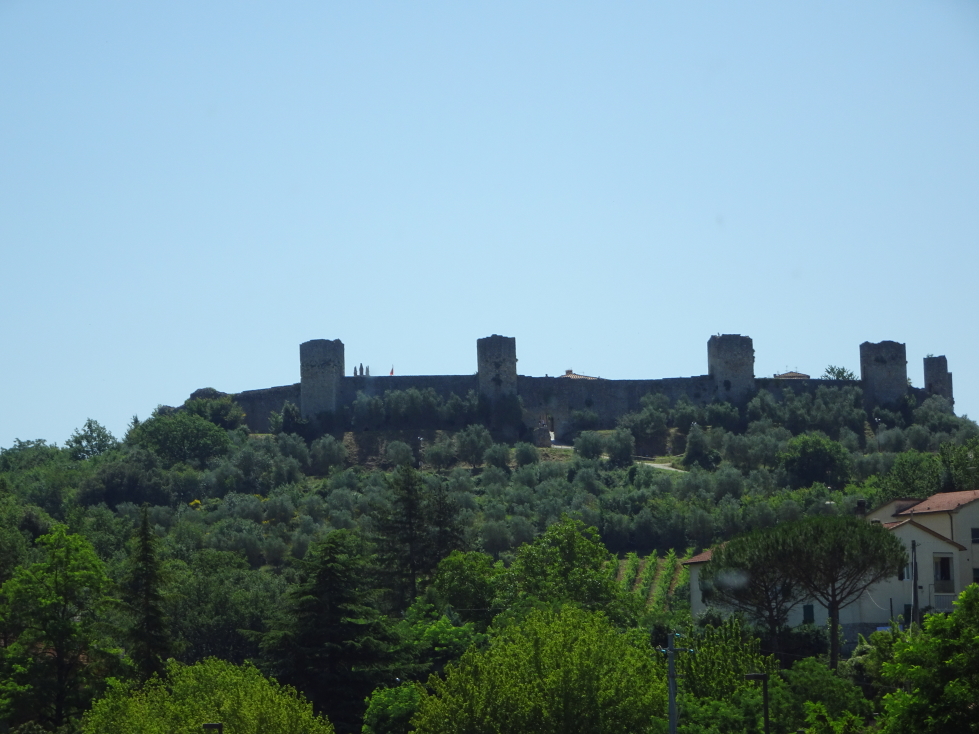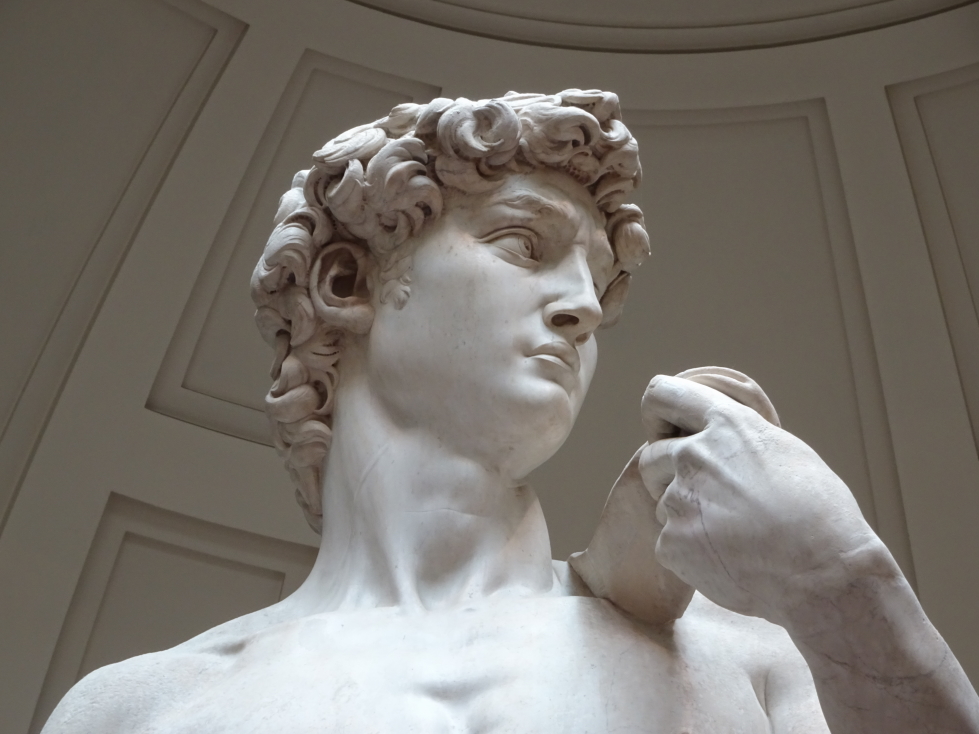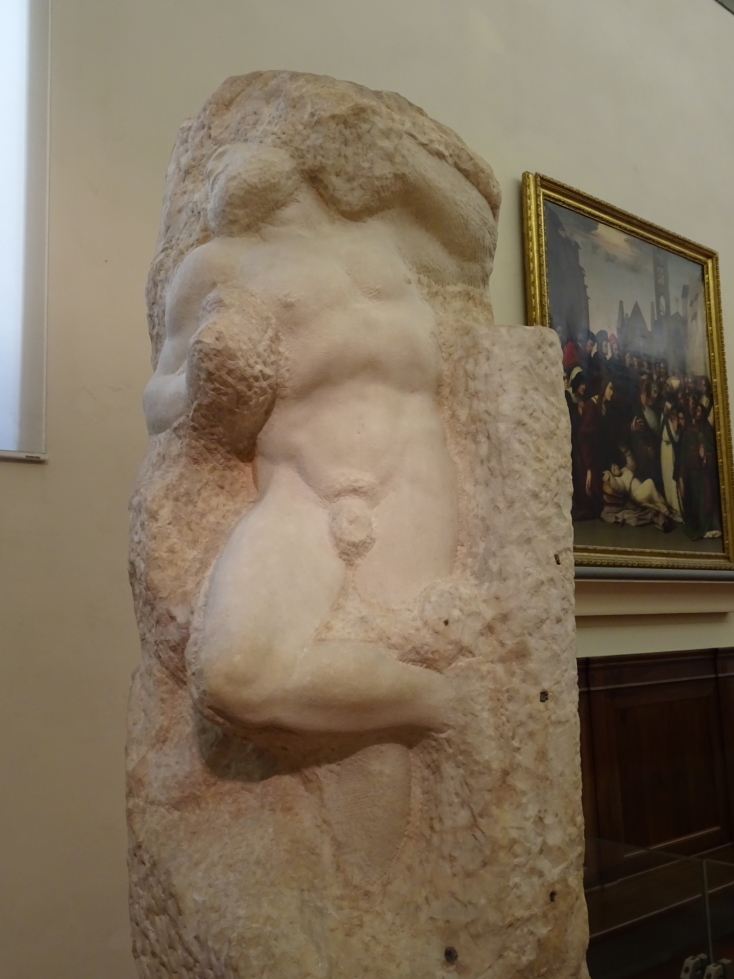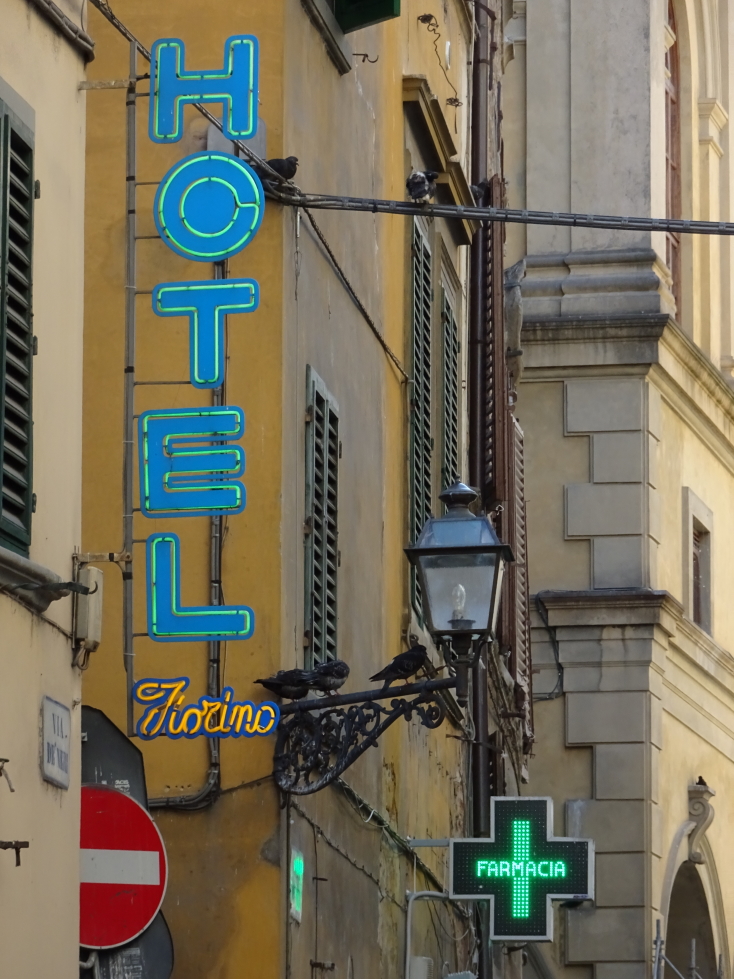We awoke at our usual 6a or so and finished readying to vacate our room at the Relais Uffizi in Florence. It was a really nice hotel, other than having a full flight of stairs up to the bathroom. Ate our normal breakfast (without Addison, he’s long since given up on Continental breakfasts) and finished getting out of our room, leaving all of our luggage and carry-ons minus the backpack with the hotel.

Sitting room of the hotel, overlooking the plaza
Walked the mile or so to Firenze SMN and hopped on board a regional train to Pisa, arriving about 12:30p. It was already getting brutally hot but we managed to shuffle our way northwards through a square honoring Victor Emmanuel II and across the river. Shortly the area became more tree-lined and shady and we stopped at a restaurant attached to a hotel called Amalfitana. Though they only had outdoor seating they had those mist generators so it wasn’t so bad. We ordered a liter of still water and three cokes. Addison had a grilled beef steak and fries, Michelle a ham and cheese (mozzarella) ommelette, and myself a salami pizza. Very tasty. We finished up with some chocolate cake (with cherries — or at least that is what I think they were — embedded in it). The bathroom had a funky square seat shape (but at least they had a seat, many restaurant toilets have no lids or seat).

Vendor selling leather goods in Florence

Colorful columns on the way to Firenze SMN

Basilica di Santa Maria Novella in Florence

Torre Guelfa on the bank of the Arno, Pisa
Refreshed, we headed back on the street, the Via Roma, heading north. We passed some university buildings and a wall with graffiti on it protesting the idea that austerity should be imposed on Italy (like in Greece) by the rest of the EU. We knew we were getting close as the street vendors selling selfie sticks (how I loathe them and the whole selfie culture) and art prints and the like were getting more numerous. We met a married couple from Scotland who currently lived in central France. They were quite worried about their pensions due to Brexit and that it may mean that they have to return home to Scotland. They were, however, happy that Iceland beat England but dismayed that Italy beat Spain as they believed Italy had cheated (though they didn’t need to).
We finally got our first glimpse of the leaning tower. It is actually the campanile, or bell tower, for the adjacent cathedral, Cattedrale di Pisa. It leans about 4 degrees off center. It had been more but through a modern engineering feat was corrected a bit. The baptistery also leans and is incredibly about the same height as the leaning tower as it looked so much shorter as it is squat. Took some pictures, including some hilarious attempts at the touristy “holding up the leaning tower” picture.

Campanile of Pisa’s cathedral, the Leaning Tower of Pisa

Really cool trees near the cathedral’s plaza

The Leaning Tower

Another view of the Leaning Tower

Baptistery adjacent to Pisa’s cathedral

Detail of the cathedral’s entrance

The cathedral’s entrance

Sculpture above the entrance to the Camposanto

View of Pisa’s Cathedral

Another view of the Camposanto

Closeup of the top of the front of the cathedral

Part of Pisa’s medieval city walls
While Michelle and Addison enjoyed the shade next to the baptistery I bought tickets for the cathedral, baptistery, and Camposanto (literally “holy field”) for 7 euros each. We passed on climbing the leaning tower as it was a very steep 18 euros each! We visited the baptistery, formally known as Battistero di San Giovanni, first. The baptistery is famous for its acoustics and a demonstration was ongoing so we had to wait until that was over. After entering we looked over the sparse decoration and waited for the next demonstration. A lady came in and sang — her singing hung in the air, echoing about the chamber, almost sounding like a round as earlier notes continued to sound on top of her current ones. Once the demonstration was over I climbed the stairs that wound about the wall of the baptistery up to the second level. Up there were fantastic views of the cathedral and its campanile.

Stained glass in the baptistery

Look up at the second floor and balcony and the modest dome

Look at the ground floor of the baptistery

Front of the cathedral as seen from the baptistery’s second floor

A closeup of the cathedral’s front

Another closeup, showing the different columns
Next we crossed the unnaturally green lawn, the Field of Miracles, to the adjacent Camposanto. Though bombed heavily with incendiary grenades by the Allies in 1944 during World War II, melting its lead roof and damaging much of its frescoes and other artifacts; it was beautifully restored by the Allies with a gorgeous green lawn with roses and an open courtyard. The covered outdoor space surrounding the courtyard was lined with frescoes, Roman sarcophagi, and a number of statues and monuments. A side chapel had some relics from a Saint (that appeared to be a very common theme throughout Italy).

Neat statue in the Camposanto

Roman sarcophagus in the Camposanto

Amazing covered walkway surrounding the Camposanto’s courtyard

The Camposanto’s courtyard
One fresco was absolutely amazing in its depiction of Hell. A devil was eating and pooping people, entrails were extracted from the damned (those that weren’t required to hold their own severed head), people were on spits over roaring fires, etc. So very metal! There was a hall with even more frescoes including the famous “Triumph of Death” but sadly it was closed for renovation. Booo!

A scary depiction of Hell — I’ll be good from now on, I promise!
Headed on to the cathedral. Sadly it was also being renovated, including not being able to see the full mosaic of Jesus which, if the feet and lower robes were anything to go by, would have been a sight to behold. There was, however, an amazing pulpit from the 1300s as well as a very intricate wood-carved ceiling. A side shrine had some amazing mosaic work and one of the lamps hanging from the ceiling supposedly inspired Galileo to formulate some pendulum theories. It is now called the Lamp of Galileo as a result.

Intricately carved pulpit of Pisa’s cathedral

Absolutely amazing carved and painted ceiling in the cathedral

Closeup of the ceiling, showing the symbol of the Medici

Altar area of the cathedral with the lowest part of the mosaic of Jesus

Stained glass in the altar area of the cathedral

Beautiful mosaic atop a doorway

Arches with alternating white and black marble

Lamp of Galileo, said to have inspired his thoughts on pendulum movement
Left the cathedral to do a little shopping. Bought our customary magnets and a couple of postcards (one that Genetta had asked us to find as she had forgotten to buy it a few weeks prior). Headed back to the train station as it was nearing 5p and we had to be in Rome that night! We did, however, make some time to take some pictures of the Arno as well as a charming church, Santa Maria della Spina, built in 1230 along its banks. We also stopped for some water as it was still hot despite being evening time.

The Arno river in Pisa

Santa Maria della Spina, a tiny church on the bank of the Arno
We rode the train from Pisa to Florence for an hour, from 6p to just after 7p. There were three Spanish tourists on the train that hadn’t validated their tickets (an easy mistake to make) and were about to be slapped with a 60 euro fine each — 180 euros (nearly $200!). A friendly Italian man pleaded their case to the ticket agent and got it lowered to 60 euros total. We walked back to the hotel a long way through a rich area, stopping for gelato along the way.
Grabbed our luggage and took a quick taxi ride back to Firenze SMN and were able to catch the 8:38p train. In our haste we almost got on the wrong train… twice! That would’ve been a disaster. It was another super fast train, tunnels in particular hurt the ears. We hit right at 250km/h. As Michelle was not feeling well she didn’t appreciate it.
Once we arrived at Roma Termini (at about 10:15p) we took a taxi ride for 14 euros to the Hotel Bolivar, a place that had become our home away from home. Checked in to room 106 — not as nice as our room those first few nights as there was a distinct rattle with the AC. As it was 10:30p our food options were limited. Michelle and I (Addison passed) decided to go to the nearby Ristorante Petrucchi. We got a liter of still water, two cokes, six wonderful slices of garlic bread, and two spaghetti alla bolognesse (spaghetti with meat sauce). Really hit the spot!
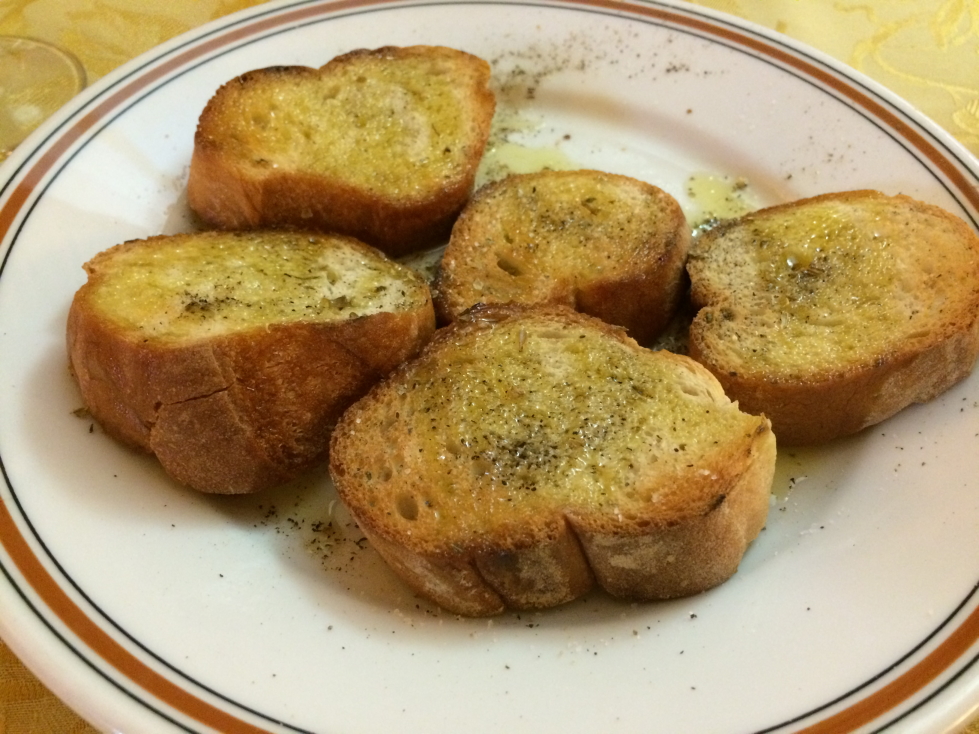
Garlic bread to die for!
Headed back to the room and tried to upload pictures (impossible due to Hotel Bolivar’s terrible, terrible internet) and blog (again, impossible). Decided to call it a night shortly after midnight.



































































